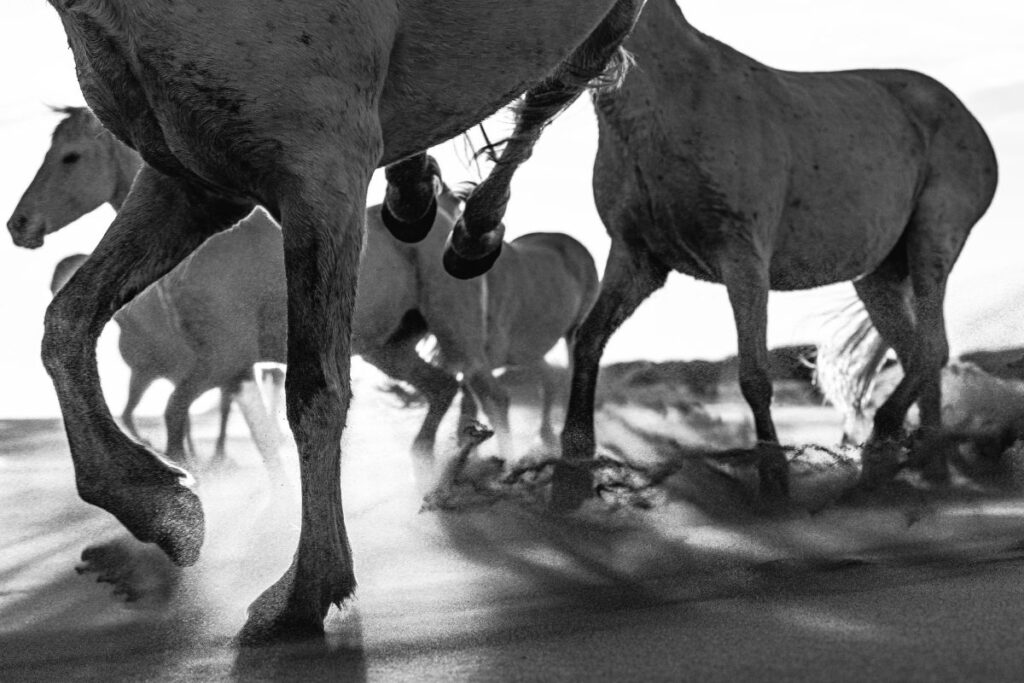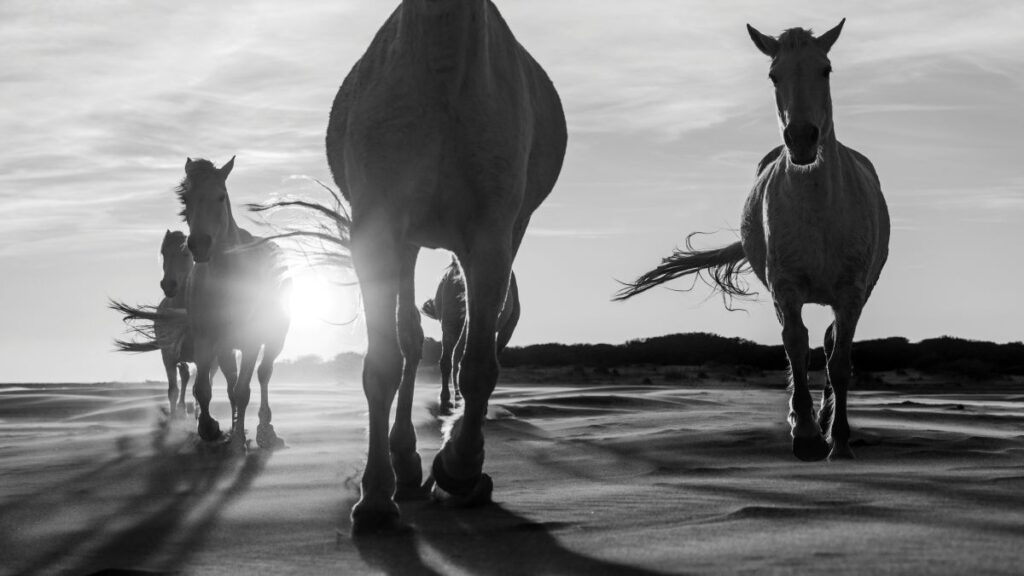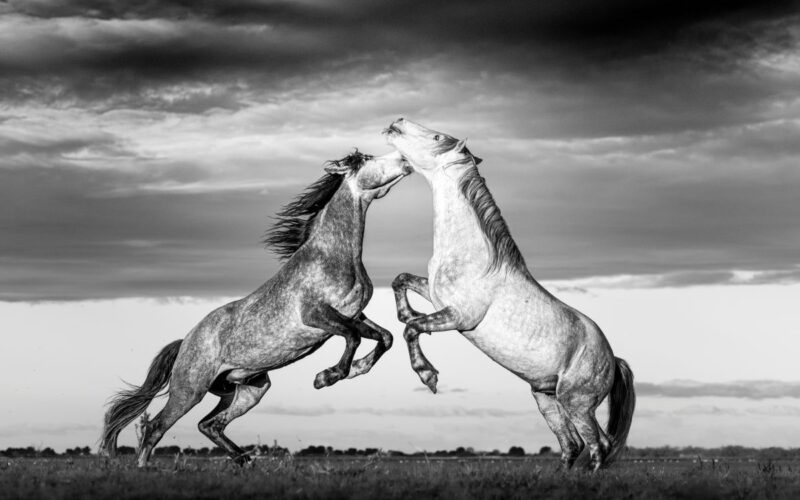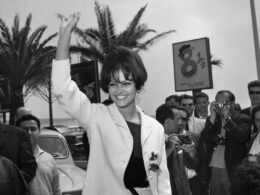Times2 talks to photographer Johan Siggesson to find out more
What inspired this new exhibition?
Horses of Salt & Wind is a series of fine art black and white photographs of the wild Camargue horses in southern France. Taken in the Camargue, where the Rhône River meets the Mediterranean, the images show these horses in the open marshlands and shallow waters that are their home. The air is full of salt from the sea and the wind rarely stops, shaping the land and everything that lives there.
This photographic series has shifted my lens from the vast savannahs of Africa to the evocative, windswept wetlands of southern France. My work normally focuses on iconic African wildlife, but I have always been drawn to the Camargue horses, one of the most iconic and ancient horse breeds in Europes. They are not fully wild animals, and they are very different from my usual subjects, but they still connect with the same theme in my work: the relationship between animals and the environments that shape them.
The photographs show the horses as they are. They move through water, sending up spray, or stand still with the wind in their manes. Their white coats reflect the light, highlighting the shape of their muscles and movement. These are not posed portraits but real moments that show both strength and elegance.
The name Horses of Salt & Wind refers to two features of the Camargue. Salt from the marshes and shallow water settles on the horses’ coats. Wind crosses the flat land, moving the water, reeds, and the horses’ manes. Both are constant parts of the landscape and influence the lives of the animals that live there.

What are the challenges and the joys of capturing the horses?
This exhibition comes from my interest in the relationship between animals and their environment. Photographing these horses was not only about showing their appearance, but also about conveying the experience of being with them in the marsh, including the feeling of a horse galloping right beside you.
This collection brings together a series of black and white images of the famed white horses of the Camargue region, captured in their natural surroundings. Here, in a unique and often stark landscape shaped by salt, water, and wind, these semi-wild horses move freely through shallow lagoons, reed beds, and flat marshes. Unlike staged or studio photographs, the images presented in Horses of Salt and Wind are all taken in situ—candid and unposed. They reflect what I saw, as I saw it. The horses were never directed or manipulated. They moved of their own accord, and I followed, waiting for the right alignment of light, movement, and emotion.
The premise behind the series is simple but powerful: to show the Camargue horses as they truly are, shaped by the elements and deeply connected to the environment they inhabit. The salt that lingers in the air, the ever-present wind that stirs their manes, and the water that often flows beneath their hooves—all these natural forces are as much a part of the images as the animals themselves. This is not just a portrait of horses; it is a portrait of a place and a way of life—both wild and weathered.
The main challenge is that the horses are unpredictable. They move fast, often in groups, and you have to be ready for sudden changes. The marshes and water can also be difficult to work in, both for movement and for keeping equipment safe. I worked with the local guardians of the Camargue, who guide and manage the horses, but once they are running or interacting the situations unfold on their own. The joy is in being close to them and seeing their strength and calm presence, especially when light and setting come together.
In Horses of Salt and Wind, I aim to go beyond mere documentation. My intent is to provide a window into something more poetic and timeless. The Camargue horses, with their flowing white coats and muscular frames, evoke a sense of myth and mystery. Seen against the raw beauty of southern France’s salt marshes and open skies, they take on an almost dreamlike presence. Through the lens of monochrome photography, these horses emerge not just as animals, but as living symbols of freedom, resilience, and elemental grace.
The choice of black and white was deliberate. Stripped of colour, the photographs focus attention on light, contrast, form, and texture. Shadows reveal the contours of powerful bodies in motion. Bright skies contrast with dark manes caught in gusts of wind. The lack of colour heightens the sense of timelessness and brings the viewer closer to the essence of the scene—allowing emotion and detail to rise to the surface without distraction.

Do you see any parallels between the landscape of the Camargue and Malta?
Both places are strongly influenced by the sea and by the wind. In Malta it is rock and coast, in the Camargue it is water and flat land, but in both cases the environment shapes daily life. The sense of exposure to the elements is similar. The connection between land and sea, and the culture that grows from it, is present in both places, even if expressed in different ways.
How do you hope viewers will feel when they visit?
Horses of Salt and Wind is both a celebration and a meditation. It celebrates the beauty, strength, and character of one of Europe’s most distinctive horse breeds, and it meditates on the larger themes of survival, tradition, and our connection to the untamed. These horses are not bred for spectacle; they are born into the landscape, shaped by centuries of adaptation to an unforgiving terrain. In their calm endurance and spirited motion, they reflect something deeply human—a will to persist, to move, to live with dignity and purpose amid the elements.
Throughout my career, I’ve consistently approached wildlife photography with a sense of subtlety and respect. I’ve always been drawn to capturing animals not in dramatized or exaggerated scenarios, but in quiet moments that reveal something authentic about their nature. This series continues that ethos. It is not about spectacle or perfection, but about presence. The horses are seen as they are—sometimes energetic, sometimes contemplative, often in quiet interaction with one another and with the world around them.
I hope visitors feel a personal response to the images, whether through the power of the animals, the calm of the landscape, or the movement of the moment. That feeling is what makes a fine art photographic print meaningful in a home or workspace.
What I hope to offer through this exhibition is not just a visual experience, but also an emotional and reflective one. By stepping into the world of the Camargue—through wind, salt, water, and sky—I invite viewers to slow down and reconnect with the rhythm of nature. To see the beauty in simplicity, the strength in stillness, and the poetry in motion.
Ultimately, Horses of Salt and Wind is as much about the environment as it is about the horses. The Camargue region, with its flat horizons, moody skies, and shifting waters, plays a central role in shaping the identity of these animals. It is a landscape that challenges and nurtures, hardens and frees—and that relationship is at the heart of this work.
Horses of Salt & Wind: Photographs by Johan Siggesson runs from September 18 – October 5 at Christine X Art Gallery, Sliema
For more on Siggeson visit www.johansiggesson.com










